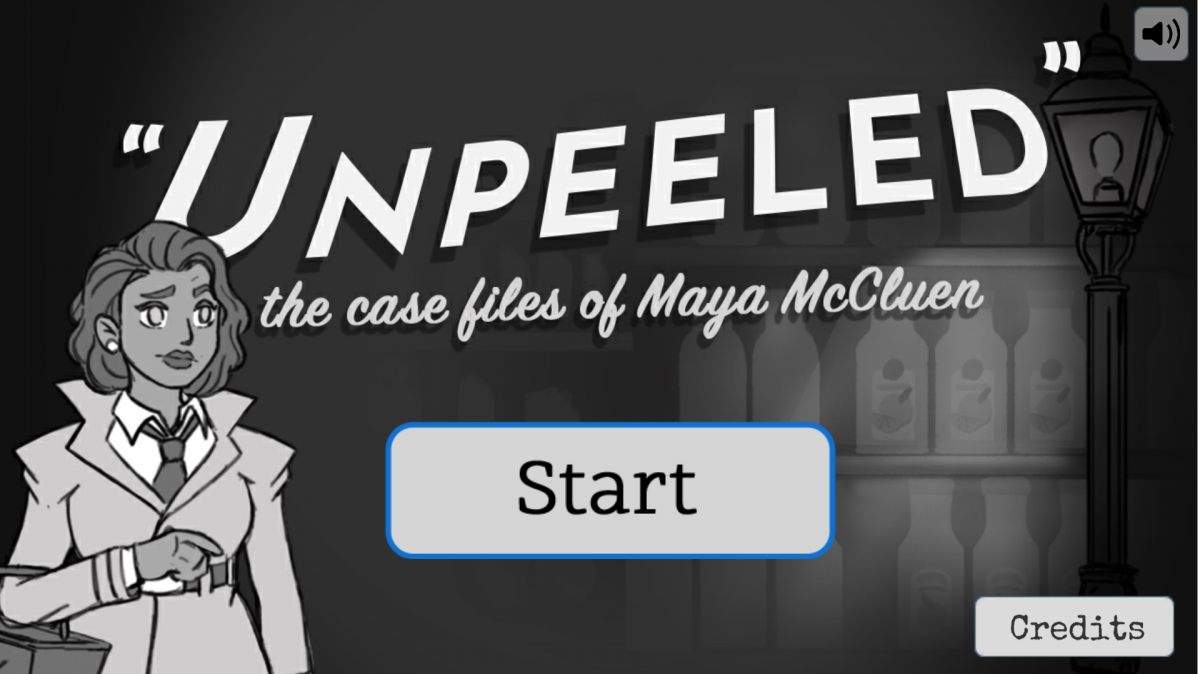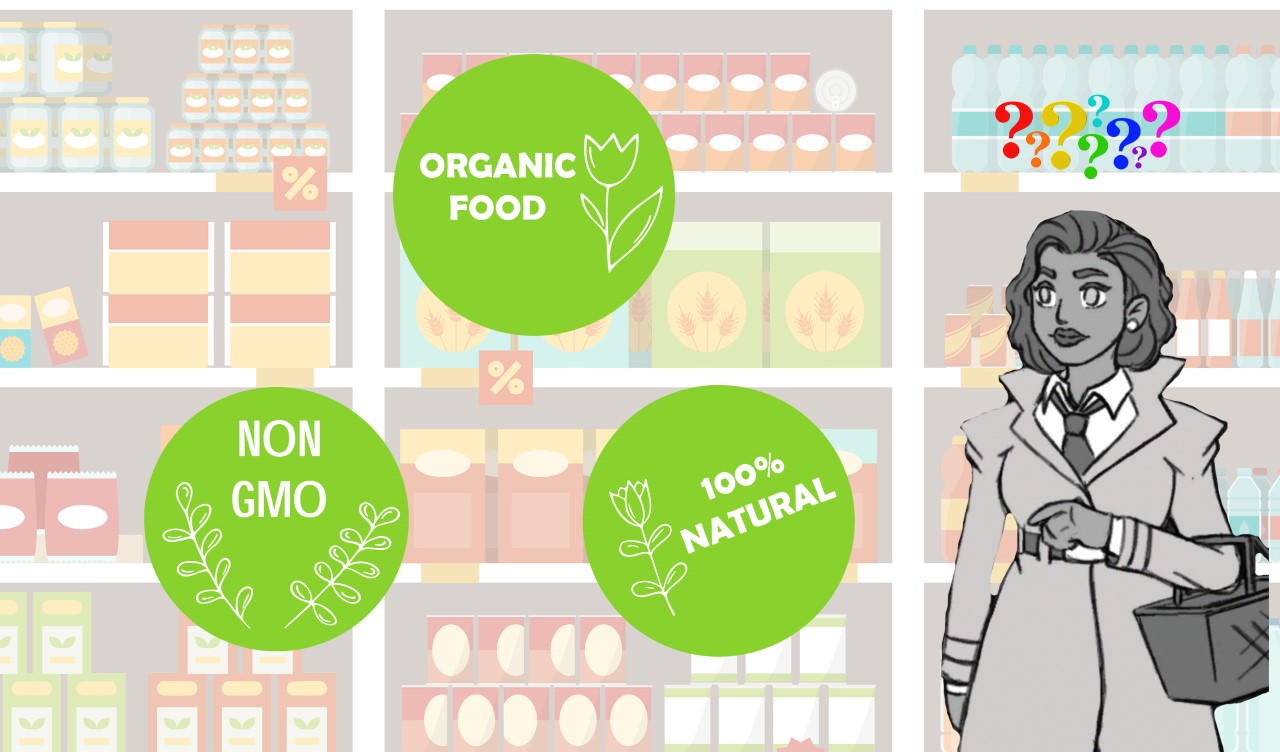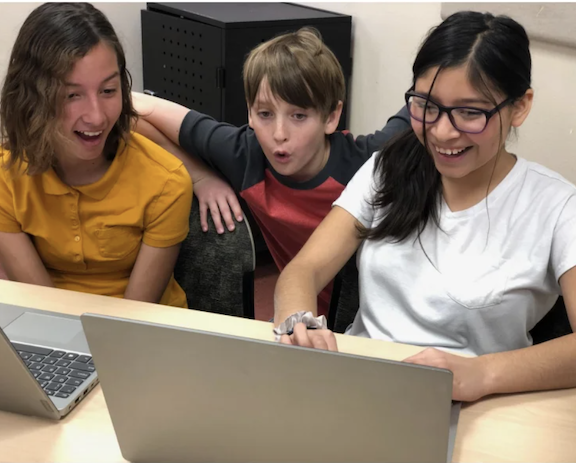
- Extension & Outreach
- Extension Programs
- Agriculture and Food
- Unpeeled: A Food Marketing Label Game
Unpeeled: A Food Marketing Label Game
Navigating the grocery store aisle is challenging for many consumers—especially those who want to buy the most nutritious food and stay within their budget.
Food manufacturers and distributors cover their boxed, canned, and bottled foods with labels like “whole grain” and “low-calorie” to suggest that their food has certain health benefits. Among the most misunderstood food marketing labels are “non-GMO,” “natural,” and “organic:”
- In a representative survey conducted by GMO Answers (2018), 69% of consumers could not define GMO (genetically modified organism), and Wunderlich et al. (2019) surveyed members of Montclair State University. They found that over 98% of respondents had heard of the term “GMO,” but only 8% of consumers were familiar with the definition.
- “Organic” foods are often credited with health and nutrition benefits that the food does not have (Noone, 2019). This is in part due to media frames that portray organic as ethical, healthier, and more nutritious (Meyers & Abrams, 2010).
- The “natural” label, which is not regulated, has various meanings depending on who is using it (Nosowitz, 2019).
The UConn Extension New Technologies in Agricultural Extension (NTAE) team developed an interactive learning activity (or game), Unpeeled: The Case Studies of Maya McCluen, in August, 2021. The purpose of this game is to increase our audiences’ understanding of food marketing labels. The development of the game is made possible through support by the Learning Games Lab at New Mexico State University. The Extension Foundation supports this team through key informant expertise to help grow the overall project.
Consumers gain knowledge about food marketing labels they read in the store and reduce confusion they may experience while grocery shopping. Play the game at https://unpeeled.nmsu.edu/.
Frequently Asked Questions
Facts About Organic Food Labels
Facts About Natural Food Labels
Facts About Non-GMO Food Labels
Is Organic Food Non-GMO?
All organic food is non-GMO.
Is organic food grown using pesticides?
Organic does not mean no pesticides are used. All pesticides must be approved by the USDA. The standard for allowed pesticides is natural and non-synthetic, not for safety. Some are toxic, some are not.
Is organic food more nutritious?
Organic food does not necessarily have a higher nutritional content than other foods.
Is organic food local?
Organic food is often produced on large farms - it does not mean it is local.
Is organic safer and better for the environment?
The term organic is a certification designation that comes from the USDA. It has nothing to do with safety, nutrition, or environmental health.
Is natural food non-GMO?
Natural foods can be GMOs and do not have to be organic. They can be grown with pesticides and the term “Natural” can be added to any food product. Natural does not mean there is higher nutritional value nor does it mean that it is non-toxic.
Does the natural food marketing label mean the food was grown naturally?
Natural labels only address how the food is processed and identifies food as not continuing any artificial or synthetic ingredients.
Are foods labeled natural certified or regulated?
There is no certification or regulatory process.
What is a GMO?
Genetically-modified organisms (GMOs) are bioengineered products where the genetics are changed on purpose using DNA technology.
Are GMOs produced by big corporations?
Not all GMOs are produced by corporations. Some are produced by universities to solve nutritional and environmental problems. 99% of scientists that study GMOs specifically understand them to be safe.
Are foods made with GMOs safe to eat?
Research states that GMO food sources do not have any more negative effects on health than foods from non-GMO sources.
Which foods have a GMO version?
The only crops or foods that have a GMO version are alfalfa, Arctic apples, canola, corn, cotton, eggplant (one variety), papaya (one variety), pineapple (one variety), potatoes, AquAdvantage salmon, soybean, squash, and sugar beets.
Does a non-GMO food label mean it’s a better choice?
Products labeled as non-GMO can be misleading if no GMO version exists.
What is the new GMO labeling law?
Effective January 1, 2022, all products made with GMO ingredients must state this, but it may be difficult to find as it could simply be a phone number or a QR code.
Field Guides
Our group of Extension professionals and educators from UConn pursued this project to increase consumers’ understanding of the non-GMO, natural, and organic food marketing labels and empower people to make more informed food buying decisions. We curated a range of science-based resources and collaborated with the Learning Games Laboratory at New Mexico State University (NMSU) to develop an interactive online learning activity (or game), “Unpeeled: The Case Files of Maya McCluen.” This Field Guide documents our team’s history; details how we developed, tested, and deployed our project; and shares a trove of research about food labels, particularly about perceptions and knowledge of GMOs. We hope our project inspires other Extension teams to create or enhance their outreach education programs.
The Field Guide, Navigating the Grocery Store Aisle: Understanding "Non-GMO" & Other Food Labels was published by the Extension Foundation and is available to read online.
Educational games can be an innovative way for Extension educators to teach content to any given audience. While many in Extension have an interest and passion for using and designing games, the process may seem intimidating to Extension professionals, especially those without experience in game design. This Field Guide offers an alternative to full game design, in which game developers, content experts, and Extension educators collaborate to design a game prototype. This modified game jam process is budget-friendly and can be completed in a few weeks.
The Field Guide, Collaborative Design in Extension: Using a Modified Game Jam to Explore Game-Based Learning was published by the Extension Foundation and is available to read online.
Additional Resources
Funding Acknowledgement
Funding for this project was made possible by the New Technologies for Agricultural Extension Program, the Extension Foundation, Northeast Ag Enhancement, and UConn Extension.






